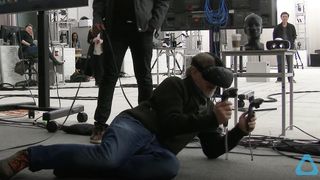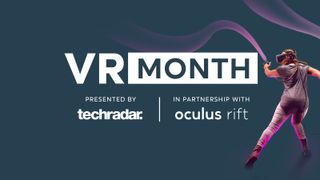VR films: the future of cinema?
Will VR become a movie linchpin or fade into obscurity?

It’s safe to say that Hollywood has begun to embrace virtual reality (VR).
Big-name directors have all rushed to try their hands at this new film-making format. Oscar winner Kathryn Bigelow created an anti-poaching VR doc The Protectors in 2017, and Alejandro G. Iñárritu actually won an Oscar for his VR installation Carne y Arena. Ridley Scott and Robert Rodriguez are also heading up their own projects.
Other directors have invested in VR companies. Steven Spielberg was one of many investors who backed Dreamscape Immersive, a free-roam, shared-experience VR theater.
Unfortunately, not every VR film venture has achieved success. IMAX launched several VR theaters in major US cities in 2017 and began developing high-end VR cameras with Google; a year later, IMAX has shuttered two VR theaters and Google halted its camera partnership to focus on augmented reality (AR) instead.
Disney’s VR startup, Jaunt XR, also chose to pivot to AR and was forced to lay off employees. Facebook also shut down its VR filmmaking wing Oculus Story Studio, though the Story Studio team then chose to found their own studio, Fable. Overall, the story of VR films thus far has been one of hype, optimism, and, sometimes, financial roadblocks.
VR has an undeniable future in the film industry. But will VR follow the path of 3D films – an explosive rise followed by a slow loss of relevance – or will it become the go-to film format in the years to come?

VR directing: a whole new medium
Last year, I attended a VR filmmaking talk at the Tribeca Film Festival, where Doug Liman – director of The Bourne Identity – talked about the thrills and challenges of shooting his VR TV series, Invisible.
Get daily insight, inspiration and deals in your inbox
Get the hottest deals available in your inbox plus news, reviews, opinion, analysis and more from the TechRadar team.
There were a fair number of challenges.
Liman said they had to re-envision cinematography, determining which Hollywood camera techniques – like zooms or jump cuts – could work without disorienting or nauseating the viewer.
He continued on that, because there’s no “behind” a VR camera, he had to direct his actors from a distance, and that unlike in 2D he couldn’t edit footage to hide one actor’s bad take. They even tried to segment the film sets, so that if the audience’s eyes wandered from the main action, they would only look at a select few locations.
That’s why so many famous directors have chosen VR for their latest projects: it’s an opportunity to be the first to discover a new cinematic technique in a new film-making medium.

Costs and demand
Of course, another reason VR attracts big-name directors is that filming high-quality VR movies can come with a significant price tag.
Beyond the usual costs of making a movie – hiring production staff and actors, post-production effects, etc. – buying specialized 360-degree cameras and hiring staff to stitch together video can cost upwards of “$10,000 per finished minute” of footage, according to the Hollywood Reporter.
With that much money going to tech costs, it’s more difficult for filmmakers to afford the talented actors that could bring VR further into the mainstream.
Whether or not that number is completely accurate, it remains true that VR films tend to be shorter and more expensive to make than traditional films. This makes it harder to charge consumers for them; people will pay $20 to watch a two-hour movie, but will they pay $5 for a 10-minute experience?
VR films also lack the reliable continued revenue streams that 2D films rely on to make a profit. Hollywood studios first release films in theaters, after which they rake in money from Blu-Ray sales, and then from licensing their films to subscription services like Netflix or HBO.
Subscription services for VR content are relatively scarce thus far, and can tend to focus on VR games instead. And as mentioned above, VR theaters are still a new and limited enterprise.
Still, VR filmmakers believe the medium can only grow once they can offer buyers longer content. This year, for example, Vive Studios produced a 70-minute VR film called 7 Miracles that depicted Jesus Christ through the lens of the Gospel of John.

How VR films could grow and change
Of course, no one at present should actually be sitting 70 minutes straight inside of a headset. Oculus recommends you take a “10 to 15 minute break for every 30 minutes” of VR.
But, outside of bringing back movie intermissions, how will filmmakers make VR films experiences that people will buy and enjoy for hours at a time?
The natural improvement of VR technology will certainly help. As future headsets improve in graphical quality, frame rates and physical comfort, longer VR sessions will be less prone to eye strain and nausea.
Plus, obviously, the more people who choose to buy VR headsets, the more likely that the VR platform will be profitable enough that filmmakers see it as an attractive option.
But filmmakers will also need to decide why their long film needs to be in virtual reality. VR has been called an “empathy machine”, helping us fully immerse ourselves in the world of the film; but will viewers want to sit passively in their worlds, or will they want to actively change and influence that world?
Some VR films, such as Oculus’s upcoming episodic Star Wars series Vader Immortal, bill themselves as being “interactive”, where the viewer’s choices influence the path of the story – like a choose-your-own-adventure novel or Telltale video game.
Some traditional filmmakers might balk at the idea of viewers controlling their stories, wanting to instead stick to one 360-degree narrative. But creating a VR film that users will want to watch and re-watch may be the best way to convince consumers to buy them.
Regardless of how VR films grow, however, VR will likely have a powerful influence on Hollywood films for years to come.
Steven Spielberg wore a VR headset to try and envision his Ready Player One world. And Variety reported that Disney employs a VR software called Cardinal that automatically generates VR storyboards out of scripts, helping directors to envision their world during the pre-production stage.
It’s difficult to predict how VR films and technology will grow in the next few years, and how VR companies will find a way to profit off of them and pay back their investors. But we’re fairly confident that the technology will have a significant impact on cinema’s future.
Supported content on TechRadar means the article has been created in partnership with a developer, publisher, manufacturer or other relevant party. When you see this disclosure note in an article, it means that the article idea has been approved by another company – a developer, hardware maker, or publisher – but that otherwise the content is planned, written, and published by TechRadar without any further approval. This is distinct from sponsored content on TechRadar, which is created entirely by a third party, and not the TechRadar editorial team.
Michael Hicks began his freelance writing career with TechRadar in 2016, covering emerging tech like VR and self-driving cars. Nowadays, he works as a staff editor for Android Central, but still writes occasional TR reviews, how-tos and explainers on phones, tablets, smart home devices, and other tech.


